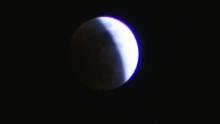UPDATE
WEDNESDAY, JUNE 15, 2011
Live feeds of lunar eclipse at Slooh, Google Earth and Times Square - latimes.com
Live feeds of lunar eclipse at Slooh, Google Earth and Times Square - latimes.com Since it’s currently pouring in Los Angeles, the only way to watch Monday night’s total lunar eclipse might be through a live feed from Google Earth and robotic telescope service Slooh.
Since it’s currently pouring in Los Angeles, the only way to watch Monday night’s total lunar eclipse might be through a live feed from Google Earth and robotic telescope service Slooh.
Live feeds of lunar eclipse at Slooh, Google Earth and Times Square
Google Earth’s Sky feature will present an ongoing visual of the celestial event, which will stretch for several hours beginning around 10:30 p.m. PST. Viewers can go to the Slooh Space Camera section -– known as a “layer” -- to watch.
It will be a coming-out party of sorts for the Google Earth-Slooh partnership, which launched in the fall.
Slooh also will show the total lunar eclipse -- the first in about three years -- on its website, with live audio commentary by astronomer Bob Berman. The phases will also appear on a large digital billboard in Times Square in New York City at 1568 Broadway.
And NASA will be hosting Web chats about the eclipse and feeding it live atNASA.gov/WatchTheSkies
For a few hours on the night of Dec. 20 to Dec. 21, the attention of tens of millions of people will be drawn skyward, where the mottled, coppery globe of our moon will hang completely immersed in the long, tapering cone of shadow cast out into space by our Earth. If the weather is clear, favorably placed skywatchers will have a view of one of nature's most beautiful spectacles: a total eclipse of the moon.
[Manmade wonders: Local guides to the best Christmas lights near you]
Unlike a total eclipse of the sun, which is only visible to those in the path of totality, eclipses of the moon can usually be observed from one's own backyard. The passage of the moon through the Earth's shadow is equally visible from all places within the hemisphere where the moon is above the horizon.
The total phase of the upcoming event will be visible across all of North and South America, as well as the northern and western part of Europe, and a small part of northeast Asia, including Korea and much of Japan. Totality will also be visible in its entirety from the North Island of New Zealand and Hawaii — a potential viewing audience of about 1.5 billion people. This will be the first opportunity from any place on earth to see the moon undergo a total eclipse in 34 months. [Amazing photos of a total lunar eclipse]
This star chart shows where in the sky the upcoming lunar eclipse will appear. And check this NASA lunar eclipse chart to see how visible the eclipse will be from different regions around the world.
Stages of the eclipse
There is nothing complicated about viewing this celestial spectacle. Unlike an eclipse of the sun, which necessitates special viewing precautions in order to avoid eye damage, an eclipse of the moon is perfectly

 (
(




